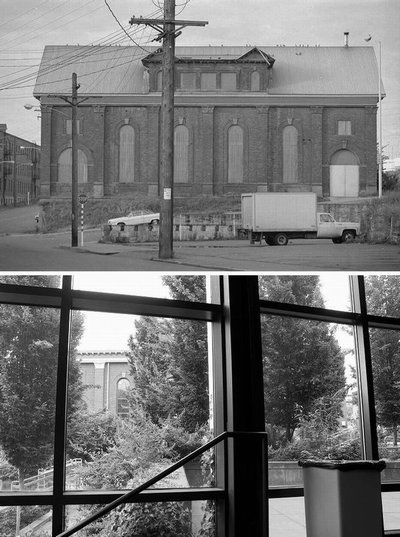July 22, 2010
That was then—this is again: Photos show UW Tacoma’s past, present
In 1979, well before UW Tacoma was born, photographer Stephen Cysewski took hundreds of photos in Tacoma’s Warehouse District. Among the buildings he photographed were the old, rundown Union Depot; a deserted power station with boarded up windows and doors; a turn-of-the-20th-century hotel long past its best days; and a dilapidated wooden schoolhouse that once served as the center of a lively Japanese community.
Those historic Tacoma places look much different now. The depot has resumed its former 1911 glory and been reborn as a federal court house. The power station has been transformed into a graceful wing of UW Tacoma’s Library. The handsome Carlton Hotel has been restored and converted into an office building and an upscale restaurant. The Japanese Language School, sadly, is gone; only a grassy lot remains.
In photographic circles, Cysewski is known for his penchant for wandering around cities, taking black and white pictures of everyday street scenes. Buildings, stairways, doorways and fences form striking angles and shapes.
A retired computer applications professor from the University of Alaska Fairbanks, Cysewski authors a dozen websites displaying his work, taken in some of the places that most intrigue him, including Fairbanks, Thailand, Seattle and Tacoma.
A couple of years ago Justin Wadland, head of media and visual resources at the UW Tacoma Library, saw Cysewski’s 30-year-old photos of the Warehouse District in an issue of City Arts magazine. A remarkable renaissance of the area has occurred since then, including the creation of the UW Tacoma campus by restoring many of the dilapidated warehouse buildings. Wadland was struck by how the places had changed. He began planning to re-photograph them. With a Founders Endowment grant to fund the project, he invited Cysewski to come from his home in Fairbanks to reshoot the photos.
David Johnson, a library research assistant, set about the daunting task of finding the locations of hundreds of the 1979 shots. Looking for the exact spot was often difficult or impossible. Some of the buildings had changed names. Some had been demolished. Sometimes new structures or trees blocked the subjects.
In spring of 2008, Johnson completed mapping the sites. Cysewski arrived from Alaska, and the team spent three days on the streets, hauling around maps, original photos and lots of equipment.
Afterwards, Wadland and Johnson sorted through some 3,000 photos, processed the digital images, cataloged them and created a searchable database. The result: 250 images of 125 places dramatically changed by time. The collection includes many sites on or near the UW Tacoma campus, including Union Station; Snoqualmie Falls Transformer Station; Carlton Building; Japanese Language School; Mattress Factory/Harmon Warehouse; and Samson Hotel.
Wadland called the project Tacoma Then and Again, rather than Tacoma Then and Now, he said, because “now” constantly changes. The later photos do not depict the final fate of the places, but only one moment in time. The places themselves are always in flux.
“In just the two years since we took the second set of photos, they have already changed,” he said.
“This is a novel way to show how history affects the landscape,” Wadland said. “The purpose is not to look at the photos and say, ‘Look how bad it was then and how good it is now.’ The photos don’t necessarily show positive change. They just show change.”
Working on the project has been an education for Wadland. “My own sense of how things change has deepened,” he said. “The most striking photos are the ones where there is nothing there now.”
One of the unique aspects of Tacoma Then and Again is that Cysewski’s first set of photos document a time when Tacomans were not proud of the Warehouse District. Other than his own, very few photos of the area at that time exist.
Another footnote, Wadland pointed out, is that in similar collections, the same photographer doesn’t usually take the second set of photos, which gave his project an advantage.
“Stephen is very skilled and knowledgeable,” Wadland said. “And very generous with his work.” He noted that the original set of photos had been donated to the Tacoma Public Library, which partnered with Wadland for the project.
Although he was happy to contribute to the project, Cysewski noted, he doesn’t usually retake photos. He makes photos that catch his eye almost unexpectedly. He likes to walk around with no particular destination or agenda, looking for everyday sights. Looking for a”magic spark” that captures his attention in the moment. He can’t define what it is that makes him want to press the shutter button, he said, and doing so would be contrary to his intentions.
“When you take pictures, it’s like an ecosystem,” he said, explaining that he responds to the environment and tries to capture the feelings and memories intrinsic to it. He doesn’t make portraits or scenic photos, which he considers idealized and superficial, and doesn’t follow standards taught in photography class, such as “the rule of thirds.”
“Buildings represent people and time and memories and history,” Cysewski said. “It’s the everyday and mundane things that make memories, not sunsets.”
So he just wanders, recording black and white moments, knowing that the places he sees through his lens will never be just like that again.
View Tacoma Then and Again: here
More of Stephen Cysewski’s “wandering” photos:

